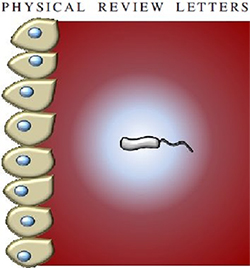Utah mechanical engineering associate professor Henry Fu recently published two papers which received special highlighting.
In the first publication that recently appeared in Physical Review Letters, University of Utah Mechanical Engineering Ph.D. student Amir Mirbagheri and professor Henry Fu study how the bacterium Helicobacter pylori swims through the gastric mucus lining the stomach. The article was highlighted as a PRL Editor’s Selection, with an accompanying synopsis on the main journal website.
“H. pylori are known to cause stomach ulcers and stomach cancer, and one of the things they needs to do to colonize the surface of the stomach is swim through its protective mucus layer,” Fu says. It accomplishes this by secreting chemicals that neutralize the acid in the stomach interior, which diffuses outwards and, helping it survive the digestive environment and also turning the mucus from a gel into a fluid in a pocket around the cell. Fu continues, “The size of the pocket turns out to also affect how fast the bacterium can swim. You can imagine that if the bacterium swims fast, it could swim right to the edge of the neutralized pocket it has made. What we’ve done is calculate how big this pocket might be, and how fast it allows the bacterium to swim.” It turns out that the pocket is large compared to the bacterium, which could have implications for the integrity and protective function of the mucus, as well as efficiency of H. pylori infection.
Fu continues, “The size of the pocket turns out to also affect how fast the bacterium can swim. You can imagine that if the bacterium swims fast, it could swim right to the edge of the neutralized pocket it has made. What we’ve done is calculate how big this pocket might be, and how fast it allows the bacterium to swim.” It turns out that the pocket is large compared to the bacterium, which could have implications for the integrity and protective function of the mucus, as well as efficiency of H. pylori infection.
The second publication in Scientific Reports focuses on modular microrobotics. The paper was written with University of Nevada, Reno Ph.D. student Farshad Meshkati and collaborators from MinJun Kim’s research group at Southern Methodist University and Drexel University.
The paper describes proof-of-principle experiments showing how microscale swimming structures made of magnetic beads can be controllably propelled by a rotating magnetic field to achieve directed assembly with other magnetic beads. Fu explains that “one of the issues we had was that magnetic and hydrodynamic interactions between the swimmer and the other beads tended to push them apart, making it difficult to achieve assembly. Farshad and I created a model of the magnetohydrodynamics of the system to predict ways to successfully and robustly achieve assembly, which were confirmed by our collaborators.” 
Eventually, Fu and collaborators hope that such modular microrobotics may assist biomedical applications of microrobots, such as for drug delivery or microsurgery, where different geometries may be needed for navigation through different environments in the body or to accomplish different tasks. The results were publicized by two popular science news websites, the American Physical Society’s PhysicsCentral and LiveScience.